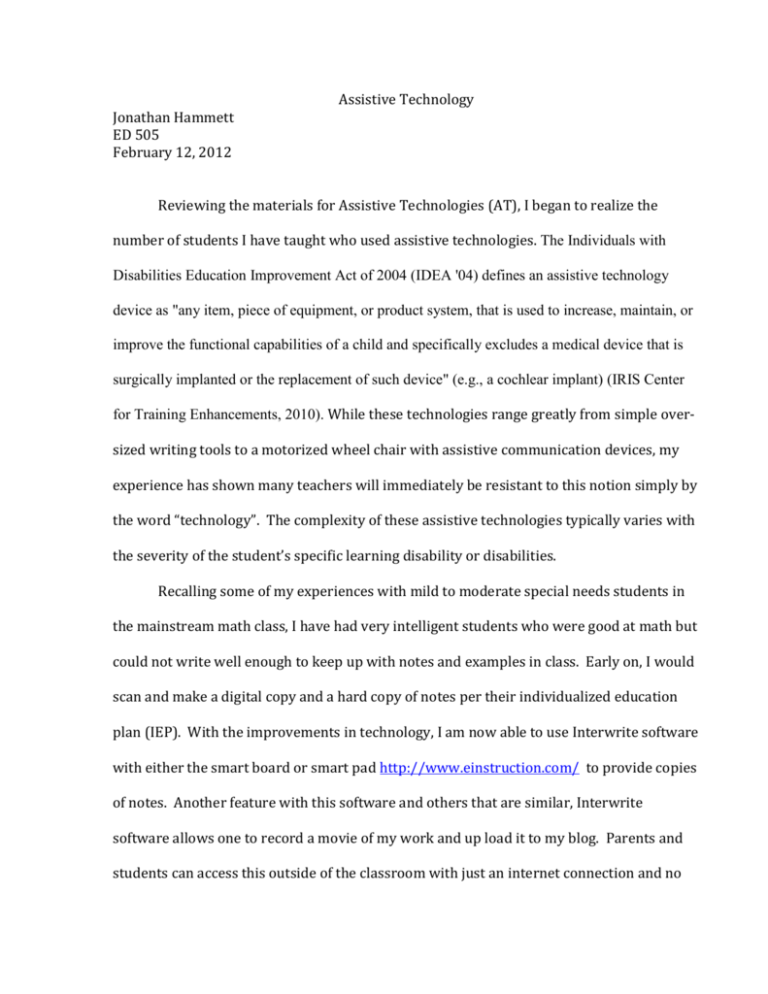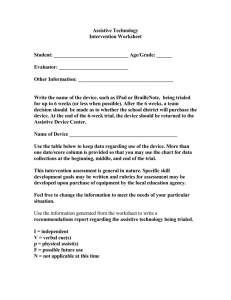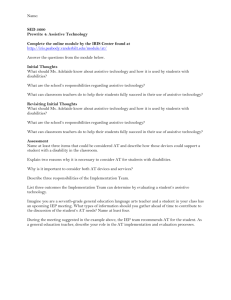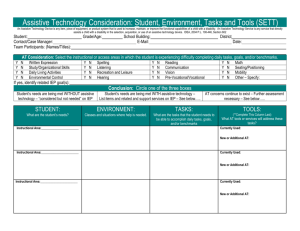Hammett Assistive Technology paper - hammett-uwa
advertisement

Jonathan Hammett ED 505 February 12, 2012 Assistive Technology Reviewing the materials for Assistive Technologies (AT), I began to realize the number of students I have taught who used assistive technologies. The Individuals with Disabilities Education Improvement Act of 2004 (IDEA '04) defines an assistive technology device as "any item, piece of equipment, or product system, that is used to increase, maintain, or improve the functional capabilities of a child and specifically excludes a medical device that is surgically implanted or the replacement of such device" (e.g., a cochlear implant) (IRIS Center for Training Enhancements, 2010). While these technologies range greatly from simple oversized writing tools to a motorized wheel chair with assistive communication devices, my experience has shown many teachers will immediately be resistant to this notion simply by the word “technology”. The complexity of these assistive technologies typically varies with the severity of the student’s specific learning disability or disabilities. Recalling some of my experiences with mild to moderate special needs students in the mainstream math class, I have had very intelligent students who were good at math but could not write well enough to keep up with notes and examples in class. Early on, I would scan and make a digital copy and a hard copy of notes per their individualized education plan (IEP). With the improvements in technology, I am now able to use Interwrite software with either the smart board or smart pad http://www.einstruction.com/ to provide copies of notes. Another feature with this software and others that are similar, Interwrite software allows one to record a movie of my work and up load it to my blog. Parents and students can access this outside of the classroom with just an internet connection and no special software other than QuickTime or Windows Media Player. In other core classes such as English or History, one student was allowed to bring his personal laptop to take notes while another student was provided an alphasmart or dana http://www.neodirect.com/ . I haven’t taught a student with a severe disability in my fifteen years of teaching. I have interacted with one student. He was confined to a motorized wheel chair that he could control speed and direction with a joystick http://www.usmedicalsupplies.com/Jazzy-614-HD-ElectricWheelchair.htm?utm_medium=base&utm_campaign=base&utm_source=google . One of the IEP requirements would allow him to leave early from one class in order to get to his next class. Many times when the aide would let him “drive”, he thought it was funny to try and drive away as if he were trying to get away from her. I would see him coming down the hallway big smile on his face and the aide not too far behind him. Not only was he confined to a wheel chair, he also had to use a communication device. Many times when I would go to one of our special education teacher’s room, he would be in there practicing with the device http://www.enablemart.com/Catalog/Communication-Software . The special education teacher’s room was across the hallway from me so I got to see him everyday. He would like to be next to me in the morning for morning hall duty. There are so many advances in technology from when I was a high school student. A good friend of mine in high school was legally blind and made better grades than I did and was amazing to be around. I remember him in my math class and he would have his math test in braille. He would use his braille machine to write his answers and it sounded like one of those ancient typewriters. As a teacher, I have had to teach a couple of visually impaired students. One of the main issues was getting tests ready early enough for them to be converted to braille http://www.enablemart.com/Catalog/Braille-Embossers/Romeo25 . I would have to send these to a central location and the test would come back to the inclusion teacher in time for the scheduled test day. With advancements in technology, it seem more reasonable for schools to have the ability to convert documents to braille locally without having to send them to a central location. However, many school systems cannot afford to have this at every school in their district. When one considers the broad range of assistive technologies from simple items to a complex set up such as a wheel chair, communication device, and visual communication device; schools are continuously having to adapt their surroundings to meet different needs at any given time. The IEP team works on the student’s plan to serve them and if necessary, collaborating with those trained in assistive technologies. These components are put together to offer the greatest chance for the student’s success. References The IRIS Center for Training Enhancements. (2010). Assistive Technology: An Over-view. Retrieved on February 12, 2012 from http://iris.peabody.vanderbilt.edu/at/chalcycle.htm








